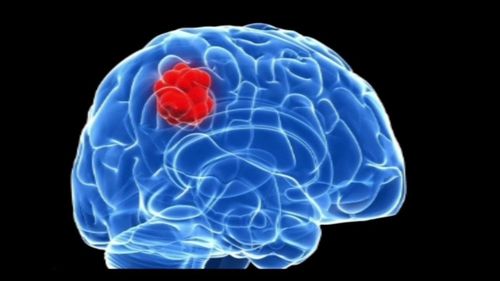This is an automatically translated article.
Childhood glioma is a tumor that grows inside the brain or spinal cord, which can be life-threatening if not detected and treated aggressively in the first place. To better understand the types of pediatric glioma as well as treatment methods, follow the specific information below!
1. What is a pediatric glioma?
A glioma is a tumor that develops in the brain or spinal cord, usually starting in the glial cells. Normally, glial cells protect, support, and insulate nerve cells in the brain, while neurons help generate electrical impulses to transmit information.
Glioma can appear in any part of the brain or spinal cord. An estimated 60% of brain tumors occur in children. In general, childhood gliomas can occur in the following brain parts:
Inferior tentacle: The lower part of the brain near the middle of the back of the head, including the brain stem and cerebellum, which helps control control balance and movement. The cerebellum is the part of the brain located at the back of the skull that helps control voluntary muscle movements such as voice, posture, coordination, and balance. Meanwhile, the brainstem is the middle part of the brain, connecting the brain to the spinal cord, helping to control eye movements, breathing, transmitting sensory information, and involuntary muscle movements. Upper tentacle: The part of the brain located above the cerebellum, which includes the cerebrum (the largest part of the brain) that helps control emotions, thinking, learning, problem solving, talking, writing, reading, and movement. voluntary action.
2. Causes and risk of glioma in children
Glioma is considered the most common type of brain tumor in both children and adults. Children who are most susceptible to gliomas are usually between the ages of 0 and 14.
Currently, the specific cause of glioma in children is still unknown. However, in the opinion of experts, childhood glioma is associated with some of the following risk factors:
Children with certain genetic syndromes or genetic mutations, including Turcot syndrome, Li-Fraumeni syndrome and neurofibromatosis. In particular, children with neurofibromatosis are particularly at risk of developing optic tract gliomas compared with other children. In addition, tuberous sclerosis syndrome also contributes to an increased risk of low-grade gliomas, namely subependymal giant cell astrocytomas. Children who have undergone treatment for certain other cancers can develop gliomas (as a secondary cancer). In most cases, the reason why a child develops a brain tumor is unknown. When a tumor forms in the brain, patients will not be able to notice it is growing and will not know they have a brain tumor until the tumor is large enough to cause symptoms due to their pressure on it. normal structures in the brain.
3. Signs and symptoms of glioma in children
As gliomas grow, they squeeze and overwhelm normal parts of the brain, causing these organs to stop working or have difficulty performing their inherent functions. The signs and symptoms of childhood glioma will depend on the location of the tumor in the brain. According to research, Gliomas in children can appear in any part of the brain with the following common symptoms:
Headaches, especially headaches that keep the child awake during the night or the pain goes away after the child vomits. Feeling of nausea with/without vomiting. If your child shows signs of intense and frequent vomiting, this may be a warning signal of a glioma rather than a gastrointestinal disease. Vision changes, such as blurred vision, double vision, or problems with hearing or speech. If the glioma is located in the optic tract, the child may experience decreased vision or a bulge in the eye (bulge of the eye). Children with gliomas may find it difficult to balance when walking, especially those with astrocytomas because they often occur in the superior tentacle. Children with symptoms of clumsiness, difficulty writing or holding objects. Children are more likely to be confused or feel drowsy than usual. Behavioral changes, including irritability or failure to meet developmental milestones relative to peers. Convulsions . Infants with gliomas often have larger heads. Children with high-grade gliomas tend to experience symptoms for a shorter time because these tumors grow faster.
4. Methods of diagnosing glioma in children
Here are the commonly used methods in diagnosing glioma in children:
History and general physical examination of the child
The first step to help diagnose glioma in children is a general physical examination as well as assessment of the child's medical history. The doctor may ask the patient's family to provide signs of changes in the child as well as all the symptoms that the baby is experiencing. Family members also need to report family history of whether any members have had brain tumors or any other cancers, because gliomas tend to run in families.
In addition, the doctor also conducts a comprehensive physical examination of the child, including a neurological exam to check the activity of the brain and spinal cord to look for any signs of abnormalities. The neurological examination usually includes the following steps: Checking the child's mental state, senses, coordination and reflexes. If the child is able to walk, the doctor will check to see if the child can walk normally.
Imaging
Pediatric gliomas can be diagnosed with imaging, which includes 2 main types:
Computerized tomography (CT) of the brain : Using X-rays to take pictures of the brain from many different angles. This method of diagnosing glioma in children is very quick. The doctor may inject dye into the child's vein before performing a CT scan to improve the image better. In general, a CT scan is usually the first type of imaging done because it takes less time to do the test. If a CT scan shows the presence of a glioma, the patient will be referred for an MRI. Magnetic resonance imaging (MRI): This diagnostic method uses magnets to take detailed pictures of brain structures from multiple angles. The doctor will inject the child's vein with Gadolinium before the scan to make certain areas of the brain brighter in the image, thereby helping to make a more accurate diagnosis. The MRI scan can take several hours and requires the patient to lie completely still during the scan. Sometimes, a child needs to take medication to make them sleepy to keep them from moving during an MRI scan. Depending on the type of glioma, your doctor may order additional MRI scans of the spine to determine if the tumor has spread to other parts of the body. Lumbar puncture (LP)
Children with high-grade glioma may need lumbar puncture (spinal tap) to detect tumor spread into spinal fluid . This diagnostic procedure involves inserting a needle into the lower back to withdraw a sample of spinal fluid. The doctor will evaluate cells from the cerebrospinal fluid for clues related to the tumor.
Biopsy
The final diagnostic method for gliomas in children is biopsy, which evaluates tumor cells under a microscope to look for cancer. The doctor will perform surgery to remove part of the tumor from the brain, then diagnose the type of tumor through observation under a microscope.
Usually, a biopsy will be done when the entire tumor is removed during surgery. Sometimes, a glioma can be located in a part of the brain and is difficult to resolve with surgery. In this case, the diagnosis will be made based on the results of the MRI scan and the treatment plan will be created based on the images obtained.
5. Classification of glioma in children
Determining the right type and stage of a pediatric glioma will help your doctor create an appropriate treatment plan for your child. Staging will depend on the size, shape and extent of the tumor under the microscope. There is currently no standard staging system for glioma in children, but the disease has been specifically classified by experts based on WHO scoring criteria. Through grading, the doctor can determine the degree of abnormality and the growth rate of tumor cells, including:
High-grade glioma in a child that looks very abnormal under the microscope . Low-grade gliomas in children often differ from normal brain cells, however they do not appear as anomalous as those of high-grade tumor cells. Types of high-grade glioma in children
The following are the types of high-grade glioma that commonly occur in children, including:
Grade 3 astrocytoma: The tumor cells have no structure similar to normal brain glioma cells. These tumors have the ability to grow in any region of the CNS and often progress more rapidly than low-grade gliomas, even with a risk of recurrence soon after treatment. However, grade 3 astrocytomas do not spread to other parts of the CNS. Multimorphic glioblastoma: This is a grade IV glioma that can appear anywhere in the brain or spinal cord. These tumors can start in one part of the brain and sometimes spread to other areas in the central nervous system. These high-grade gliomas are typically more aggressive and grow faster than low-grade tumors, and are more likely to recur after treatment. Diffuse midline glioma, H3 K27M mutation (formerly known as diffuse intrinsic glioma (DIPG)): A high-grade tumor that develops in the brain stem, accounting for 10% of all cases glioma in children. Pediatric patients with these tumors often experience neurological changes. Types of low-grade gliomas in children
Types of low-grade gliomas in children usually include:
Hairyoma: A low-grade (grade I) type of glioma made up of rhombus-like cells. Astrocytomas are considered the most common low-grade glioma in children, usually occurring in the cerebellum or any part of the central nervous system. The most common type of hairy astrocytoma today is juvenile astrocytoma (JPA), which accounts for 20% of brain tumors in children. Most low-grade astrocytes tend to grow slowly, not being detected until they are fully grown and cause obvious symptoms. Optic glioma: A low-grade glioma that occurs in the optic nerve (the wire that goes to the eye). Rectal glioma: A low-grade glioma that occurs near the brain stem. Glioblastoma oligodendroblastoma: A very rare low-grade glioma in children. Ganglion glioma: A low-grade glioma that has some features similar to glial cells and neurons. Polymorphic astrocytoma: A low-grade glioma with a cyst within the tumor. Polymorphic astrocytomas tend to develop superficially in the temporal lobes of children's brains.
6. How to treat glioma in children
Treatment for glioma in children will be determined based on many factors, including the age of the child, the symptoms of the disease, the type of glioma being treated, and the goals of treatment. To treat this disease, doctors can apply a combination of methods together.
Currently, the main options for the treatment of pediatric glioma typically include surgical removal of the tumor, chemotherapy, and radiation therapy. If the patient does not have symptoms associated with low-grade glioma, the doctor may order only close monitoring without the need for treatment.
Surgery to treat glioma in children
If a CT or MRI scan shows a glioma in the brain, the doctor will perform a biopsy or surgically remove the tumor. Surgery is considered the mainstay of treatment for both low-grade and high-grade gliomas in children, making it safe to remove as much of the tumor as possible.
The neurosurgeon will use the results of the CT or MRI scan to come up with a specific surgical plan. Tumors can be resected total (100%), nearly total (>90%), subtotal resection (51-90%) or partial (10-50%) during surgery. art.
Although surgery removes most tumors, many studies show that this treatment alone is not enough. Most pediatric glioma patients require radiation therapy or chemotherapy to completely remove the brain tumor. Because, in some cases, brain tumors are located in parts of the brain that are difficult to access with surgery, especially brain stem and visual glioma types. For this situation, the child will not receive surgery, but only chemotherapy or radiation.
Radiation therapy for gliomas in children
Radiation therapy uses high-energy particles or X-rays to shine directly at the glioma tumor, thereby helping to destroy abnormal cells in the brain. The dose of radiation used will depend on the type and location of the tumor and the age of the child. However, radiation therapy can cause some side effects, especially long-term developmental problems for children. Therefore, radiation therapy is often delayed by doctors for as long as possible for pediatric patients so that the child has a chance to develop healthy before this procedure.
Currently, there are 2 main types of radiation therapy used in the treatment of gliomas in children, including:
Photon Radiation: This is a traditional form of radiation therapy, using X-rays aimed at the tumor. The radiation goes into the body, through the tumor, and then out from the other side of the body. Then in addition to the tumor itself, the tissues on both sides of the tumor were also treated with radiation. Proton radiation therapy: Protons will enter the body at the highest dose at the site of the glioma in children. This therapy does not deliver much radiation to the tissues on either side of the tumor and only reaches an important part of the body, such as the brain. Chemotherapy for gliomas in children
Chemotherapy is drugs used to treat cancer, usually given through an intravenous (IV) line, into a muscle or spinal fluid. After surgery, children with high-grade gliomas receive chemotherapy in addition to radiation. Some children may have chemotherapy before surgery to shrink and remove more of the tumor. Currently, chemotherapy drugs are used to treat high-grade glioma in children, including: Carboplatin, Vincristine, Lomustine, Temozolomide, Bevacizumab, Irinotecan or Vorinostat. Pediatric patients with low-grade glioma who cannot remove the tumor surgically may receive chemotherapy.
Immunotherapy for glioma in children
Immunotherapy drugs use the child's own immune system to destroy cancer cells. The doctor will ask the patient to perform tests to identify proteins, genes and other characteristics of the tumor, thereby recommending immunotherapy.
Currently, the immunotherapy being used to treat pediatric glioma is a monoclonal antibody (Bevacizumab). This drug works by blocking certain proteins on tumor cells and slowing their growth.
In a nutshell, a glioma is a tumor that develops in the brain or spinal cord, usually starting in the glial cells. The specific cause of glioma in children is unknown. As gliomas grow, they squeeze and overwhelm normal parts of the brain, causing these organs to stop working or to have difficulty performing their functions.
Please dial HOTLINE for more information or register for an appointment HERE. Download MyVinmec app to make appointments faster and to manage your bookings easily.
Reference source: oncolink.org












